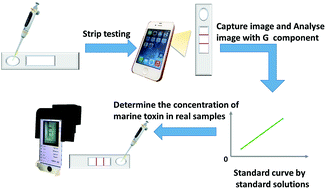A sensing smartphone and its portable accessory for on-site rapid biochemical detection of marine toxins
Abstract
Okadaic acid (OA) and saxitoxin (STX) are common marine toxins which can accumulate in shellfish and affect human health through the food chain. A convenient and efficient method is urgently required to perform on-site detection of marine toxins to avoid frequent poisoning incidents. In this work, a smartphone-based system cooperating with competitive immunoassay strips was designed for rapid on-site detection of OA and STX. The smartphone was employed as a light detector for image acquisition and data processing. The 3D-printed portable accessory of the smartphone was utilized to fix the test strips. The homemade APP – iStrip used the pixel scan to obtain the valley value of the pixel curve as the output of the strip. The strip analytical method was easy to operate with a detection limit of 2.800 ng ml−1 for OA and 9.808 ng ml−1 for STX. Moreover, with the optimization of the antigen–antibody ratio on the strip, it provided quantitative analysis of OA and STX in the range of 3–20 ng ml−1 and 10–100 ng ml−1, respectively. Taking advantage of the smartphone and biochemical analysis, the strip analytical system will be a promising tool for on-site rapid detection of these two toxins.


 Please wait while we load your content...
Please wait while we load your content...